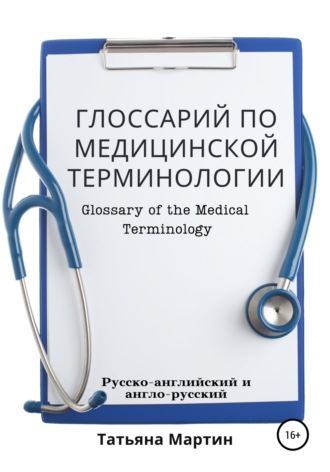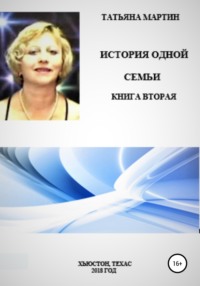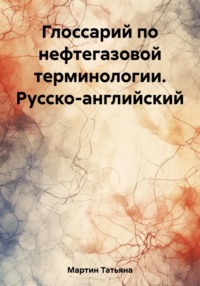
Полная версия
Глоссарий по медицинской терминологии, русско-английский
Артроцентез – это пункция сустава (внутрисуставная пункция, артроцентез) – это манипуляция, которая выполняется с диагностической или лечебной целью.
Arthrocentesis is a surgical puncture of a joint by the needle. Fluid for analysis.
Артрограмма – это изображения сустава, которые могут быть получены с помощью рентгеновских лучей, компьютерной томографии (КТ) или магнитно-резонансной томографии (МРТ) после введения контрастного вещества.
An arthrogram is an X-ray of a joint after injection of a contrast medium.
Артрография – диагностический метод исследования суставов, предусматривающий введение в их полость контрастного вещества и применение рентгеновских лучей.
Arthrography is an X-ray of a joint after injection of a contrast medium that makes the joint visible.
Артропластика – это метод оперативного лечения патологии суставов, целью которого является восстановление их функции.
Arthroplasty is a surgical reconstruction of a joint.
Артроскопия (артроскопическая хирургия) – малоинвазивная методика, позволяющая проводить диагностику и лечение внутрисуставных повреждений и заболеваний. Это разновидность эндоскопии.
Arthroscopy is a visualization interior of a joint by endoscopy.
Ревматоидный фактор (РФ) – это аутоантитела, которые ошибочно атакуют собственные ткани организма, принимая их за чужеродные. Анализ крови на ревматоидный фактор используется в качестве маркера воспалительной и аутоиммунной активности.
Rheumatoid factor is a blood test measures present unusual antibodies that develop rheumatoid arthritis.
Скорость оседания эритроцитов (СОЭ) – это показатель при анализе крови служит косвенным признаком текущего воспалительного или иного патологического процесса.
Erythrocyte sed rate is a blood test. Elevated set rates are associated with an inflammatory condition.
Секция 4 Мышечная система;
Section 4 Muscular system
Мышцы, или мускулы – органы, состоящие из мышечной ткани; способны сокращаться под влиянием нервных импульсов. Часть опорно-двигательного аппарата.
Muscle tissue consists of fibers of muscle cells connected in sheets and fibers. A nerve impulse traveling from the brain or another outside signal tells the muscle to contract.
Первый тип – Скелетные (произвольно сокращающиеся). Большинство скелетных мышц прикрепляются к костям (через сухожилия). Их сокращения контролируются сознанием, а также автоматически через рефлексы.
First type – Skeletal muscles (voluntary and striated muscles). Attached to the bones of skeleton. Some do not attach to the skeleton (face, eyes, tongue, and pharynx). Operate under conscious control.
Второй тип – Гладкие мышцы. Гладкие мышцы состоят из одиночных веретеновидных клеток и выполняют непроизвольные сокращения. Они являются важной составной частью стенок мышечных полых органов.
Second type – smooth muscles (visceral and involuntary muscles). Smooth muscles are in the walls of hollow organs and tubes. Stomach, intestines, respiratory passageways, and blood vessels. Regulated by hormones and the autonomic nervous system.
Третий тип- Сердечная мышца. Сердечная мышца (миокард) – это непроизвольно поперечнополосатая мышца, которая составляет основную ткань стенок сердца. Сокращается импульсами. 72 раза в минуту.
Third type – Cardiac muscles (involuntary and striated muscles). Forms the wall of the heart. Regulated by the autonomic nervous system.
Сухожилие – это особые продолжения мышц, соединяют мышцу с костью. Часть волокон входит в структуру кости.
Tendon is a strong fibrous band of tissue that attaches muscles to the bone. Some become continuous with the periosteum of the bone.
Сухожильное влагалище – это муфта с двойными стенками. В области лодыжки и запястья сухожилья заключены в оболочки (влагалища).
Tendon sheath is a sleeve with double walls. In the area of the ankle and wrist, the tendons are enclosed in sheaths.
Ацетилхолин содержится в пузырьках на конце двигательного нерва, лопается под воздействием электрического импульса и возбуждает мышцу.
Acetylcholine is the chief neurotransmitter of the parasympathetic nervous system, the part of the autonomic nervous system that contracts smooth muscles, dilates blood vessels, increases bodily secretions, and slows the heart rate.
АТФ (аденозинтрифосфатоза) – это энергия, образующаяся при сгорании кислорода и пищи в метохондриях. Энергия необходимая для мышечного сокращения.
Adenosine triphosphate (ATP), an energy-carrying molecule found in the cells of all living things. ATP captures chemical energy obtained from the breakdown of food molecules and releases it to fuel other cellular processes.
4.1. Патологические состояния. Мышечная система;
4.1. Pathological conditions. Muscular System.
Мышечная дистрофия – это патологическое заболевание, прогрессирующая мышечная слабость и дегенерация мышц.
Muscular dystrophy, is a genetical transmitted disorder. Muscle weakness. Muscle fibers degenerate. Progress diseases with all muscles and late stages controlling respiration.
Полимиозит – системное аутоиммунное заболевание мышечной ткани (в основном мышц поперечнополосатой мускулатуры).
Polymyositis, is a chronic progressive disease in skeletal muscles (hips and arms)
Повреждения мышц и сухожилий могут быть следствием внешнего воздействия, микротравма, вследствие незначительного напряжения пораженных структур и тканей, либо в результате многократных субмаксимальных перегрузок (скрытая травма).
Strains. Injury of the muscles or tendons. Resulting from overstretching, overextension "muscle pull".
4.2. Диагностика и лечение.
4.2. Diagnostic and treatment
Биопсия мышц – инвазивное исследование, предусматривающее отсечение небольшого образца ткани для гистологического изучения.
Muscle biopsy, is an extraction of the specimen of muscle tissue by needle or incisional.
Электромиография (ЭМГ) – это метод исследования биоэлектрической активности мышц и нервно-мышечной передачи.
Electromyography, is a recording of the strength of a muscle contraction under stimulatio by an electrical current.
Секция 5 Нервная система
Section 5 Nervous system
Нервная система участвует в сенсорном восприятии органами чувств и регулировании всех функций в организме.
Nervous System functions to regulate and coordinate all body activities, including mental, learning, and memory.
Центральная и периферическая нервная системы – это головной, спинной мозг и 12 пар – черепно-мозговые и 31 пара – спинномозговые нервы
Central nervous system (CNC) and Peripheral nervous system (PNS). Brain and spinal cord.
Нейроны – это действующие элементы нервной систтемы
Neuron and neuroglia are functional unit, nerve cell.
Сенсорные нейроны передают информацию от органов чувств в центральную нервную систему.
Afferent neurons are sensory neurons that carry nerve impulses from sensory stimuli towards the central nervous system and brain.
Интернейроны соединяют спинномозговые моторные и сенсорные нейроны. Помимо передачи сигналов между сенсорными и моторными нейронами, интернейроны могут также взаимодействовать друг с другом, образуя цепи различной сложности.
Interneurons connect the spinal motor and sensory neurons. As well as transferring signals between sensory and motor neurons, interneurons can also communicate with each other, forming circuits of various complexity.
Двигательные нейроны возбуждают произвольные и непроизвольные движения.
Efferent neurons carry neural impulses away from the central nervous system and towards muscles to cause movement.
Дендриты проводят импульсы к клеткам организма. Нервные волокна.
Dendrites conducts impulses toward the cell body.
Аксон проводят импульсы от клеток организма. Нервные волокна.
Axons conducts impulses away from the cell body.
Синапс – это расстояние между аксоном и дендритом другого нейрона.
Synapse is a space between the axon of the one neuron and the dendrite of another neuron.
Медиатор – это химическое вещество для передачи сигнала от одного нейрона к другому.
Neurotransmitters are a chemical substance that activates or inhibits the transmission of nerve impulses across the synapses.
Нейроглия, клетки нервной ткани, выполняющие важнейшие функции по поддержанию процессов жизнедеятельности нейронов и принимающие участие специфических нервных процессах.
Neuroglia, is a support system for neurons. Engulfing and digesting any unwanted substances (phagocytosis). Do not conduct impulses.
Астроцит – тип нейроглиальной клетки звёздчатой формы с многочисленными отростками, являются опорными клетками нейронов, обеспечивающими их питание и физическую поддержку, а также участвуют в процессе передачи и обработке информации в нервной ткани.
Astrocytes are star-shaped cells, the largest. Form blood-brain barrier to prevent harmful substances from brain tissue.
Микроглии – самые мелкие из глиальных клеток. Основная функция микроглий – защита от различных инфекций и повреждений нервных клеток мозга, а также удаление продуктов разрушения нервной ткани, в том числе токсичных белков, связанных с возрастной потерей памяти и другими синдромами ухудшения интеллектуальных способностей.
Microglia phagocytic cellular debris, waste products, and pathogens within nerve tissue.
Олигодендроциты представляют собой тип нейроглии, основные функции которой заключаются в обеспечении поддержки и изоляции аксонов. Они формируют миелиновые оболочки на аксонах нейронов мозга, что усиливает проведение электрического сигнала.
Oligodendrocytes form protective myelin sheath for protected axons. Electrical insulator and helps speed of nerve impulse.
Периферическая нервная система представляет собой совокупность черепно-мозговых и спинномозговых нервов, отходящих от головного и спинного мозга и связывающих центральную нервную систему со всеми рецепторами и исполнительными органами.
The main function of the peripheral nervous system (PNS) is to carry information from the sensory organs and internal organs to the CNS and convey information between the CNS and all other parts of the body outside the brain and spinal cord.
Нервы – это 12 пар – черепно-мозговые и 31 пара – спинномозговые.
Nerves, it is 12 pairs of cranial nerves and 31 pairs of spinal nerves.
Соматическая система собирает информацию от органов чувств, передает сигналы к скелетным мышцам, находится под постоянным контролем человека.
Somatic Nervous System (SNS) is the one that allows conscious (voluntary) control of skeletal muscles.
Вегетативная система участвует в бессознательном контроле за органами и системами. Контролируется Гипоталамусом
Autonomic Nervous System (ANS)has the unconscious (involuntary) control of the body; is regulated through the brainstem to the spinal cord and organs. Autonomic functions include control of respiration, cardiac regulation, vasomotor activity, and certain reflex actions such as coughing, sneezing, swallowing, and vomiting. The hypothalamus, just above the brain stem, acts as an integrator for autonomic functions.
Симпатическая нервная система отвечает за реагирование на надвигающуюся опасность или стресс и вместе с другими физиологическими изменениями отвечает за увеличение частоты пульса и кровяного давления, а также при появлении чувства волнения способствует повышению уровня адреналина.
The sympathetic nervous system connects the internal organs to the brain by spinal nerves. When stimulated, these nerves prepare the organism for stress by increasing the heart rate, increasing blood flow to the muscles, and decreasing blood flow to the skin.
Парасимпатическая нервная система, напротив, становится заметной, когда человек отдыхает и чувствует себя расслабленно, она отвечает за такие вещи, как сужение зрачков, замедление сердцебиения, расширение кровеносных сосудов и стимуляцию работы пищеварительной и мочеполовой систем.
The parasympathetic nervous system is responsible for the body's rest and digestion response when the body is relaxed, resting, or feeding. The parasympathetic nervous system decreases respiration and heart rate and increases digestion.
Гипоталамус осуществляет связь между центральной нервной системой и периферической. Также соединен с гипофизом.
Hypothalamus, is a portion of the brain with a variety of functions. One of the most important functions of the hypothalamus is to link the nervous system to the endocrine system via the pituitary gland.
Центральная нервная система – это центральный процессор всех систем организма.
Central nervous system (CNC). The brain plays a central role in the control of most bodily functions, including awareness, movements, sensations, thoughts, speech, and memory. Some reflex movements can occur via spinal cord pathways without the participation of brain structures.
Головной мозг человека (лат. encephalon) является органом центральной нервной системы, состоящей из множества взаимосвязанных между собой нервных клеток и их отростков.
The human brain is the central organ of the human nervous system, and with the spinal cord makes up the central nervous system. The brain consists of the cerebrum, the brainstem, and the cerebellum.
Передний отдел мозга, представленный большими полушариями. Процесс мышления, память, сознание и высшая умственная деятельность.
Cerebrum is the process of control memory, sensations, emotions, voluntary movements, consciousness, and higher mental activity.
Кора больших полушарий головного мозга или кора головного мозга (лат. cortex cerebri) – структура головного мозга, слой серого вещества толщиной 1,3–4,5 мм, расположенный по периферии полушарий большого мозга и покрывающий их.
The cerebral cortex and surface of the cerebrum, the outermost layer of the brain, made up primarily of grey matter. There are four lobes in the cortex, the frontal lobe, parietal lobe, temporal lobe, occipital lobe.
Между полушариями проходит продольная щель большого мозга, ограниченная краями полушарий и мозолистым телом.
Longitudinal fissure divides cerebrum on two hemispheres: right and left.
Извилина (лат. gyrus, множ. gyri) – выступы (складки), лежащие между бороздами (углублениями) на поверхности полушарий конечного мозга. Борозды и извилины создают характерную «морщинистую» поверхность полушарий головного мозга человека.
The gyri (gyrus) are the ridge on the surface of the brain; surrounded by fissures known as sulci. Gyri have an evolutionary function; they increase the surface area of the brain.
Борозда (лат. sulcus, множ. sulci) – углубления (желобки) на поверхности полушарий конечного мозга. Небольшие борозды окружают извилины (складки), более крупные и глубокие борозды разделяют доли и полушария.
The sulci (sulcus) is a groove in the cerebral cortex, surrounds a gyrus. The larger sulci are usually called fissures.
Промежуточный мозг располагается между средним и передним мозгом. Основными образованиями промежуточного мозга являются таламус (зрительный бугор) и гипоталамус. Последний соединен с гипофизом – главной железой внутренней секреции.
Diencephalon locates between the cerebrum and midbrain. It consists of several structures: the thalamus, hypothalamus, and pineal gland.
Средний мозг – располагается между подкоркой и задним участком мозга, находится в самом центре органа. Представляет собой связующий сегмент между верхними и нижними структурами, так как через него проходят нервные мозговые тракты.
Midbrain is the topmost part of the brainstem, the connections between the brain and the spinal cord.
В состав заднего мозга входят продолговатый мозг, мозжечок и варолиев мост.
Posterior includes the bridge and cerebellum.
Мозжечок учувствует в поддержании мышечного тонуса, координации движения и равновесия.
Cerebellum maintaining muscle tone, coordinating normal movement and balance.
Ствол мозга соединяет головной мозг со спинным. Проходит через все три отдела мозга
The brain stem is a region between the diencephalon and the spinal cord. It consists of the midbrain, pons, and medulla obligate.
Продолговатый мозг (medulla oblongata) является продолжением спинного мозга. В продолговатом мозге находятся нервные центры многих рефлексов: дыхания, сердечно-сосудистый, потоотделения, пищеварения, сосания, моргания, мышечного тонуса.
The medulla oblongata is a continuation of the spinal cord within the skull, forming the lowest part of the brainstem and containing control centers for the heart and lungs.
Мост является частью ствола мозга. Через мост проходят все восходящие и нисходящие пути, связывающие передний мозг со спинным мозгом, с мозжечком и другими структурами ствола.
The bridge (pons) contains nuclei that relay signals from the forebrain to the cerebellum, along with nuclei that deal primarily with sleep, respiration, swallowing, bladder control, hearing, equilibrium, taste, and others.
Ретикулярная система – это пункт контроля обратной связи. Получает и передает электрические импульсы от всех нервных клеток.
Reticular formation set of interconnected nuclei that are located throughout the brainstem; includes neurons located in different parts of the brain. The reticular formation includes ascending pathways to the cortex in the ascending reticular activating system (ARAS) and descending pathways to the spinal cord via the reticulospinal tracts.
Мозолистое тело – это толстый пучок нервных волокон. Полушарии головного мозга взаимодействуют друг с другом через мозолистое тело.
The Corpus callosum is a wide, thick nerve tract, consisting of a flat bundle of commissural fibers beneath the cerebral cortex in the brain. It spans part of the longitudinal fissure, connecting the left and right cerebral hemispheres, enabling communication between them. It is the largest white matter structure in the human brain.
Базальное ядро – это серое вещество в центре полушарий. Контрольная система, координирующая мышечную бессознательную деятельность.
Basal ganglia are a group of subcortical nuclei situated at the base of the forebrain and top of the midbrain. Basal ganglia are strongly interconnected with the cerebral cortex, thalamus, brainstem, and several other brain areas. The basal ganglia are associated with a variety of functions, including control of voluntary motor movements, procedural learning, habit learning, eye movements, cognition, and emotion.
Таламус выполняет роль коммутатора между спинным мозгом и полушариями головного мозга.
The thalamus is a small structure within the brain located just above the brain stem between the cerebral cortex and the midbrain and has extensive nerve connections to both. The main function of the thalamus is to relay motor and sensory signals to the cerebral cortex.
Эпифиз – это эндокринная железа неврогенной группы, представлена небольшим шишковидным телом серовато-красноватого цвета, располагающимся в области четверохолмия среднего мозга.
The pineal body, also called conarium, epiphysis cerebri, pineal gland, or pineal body, is the source of melatonin, a hormone derived from tryptophan that plays a central role in the regulation of circadian rhythm (the roughly 24-hour cycle of biological activities associated with natural periods of light and darkness).
В коре головного мозга можно выделить четыре доли: затылочную, теменную, височную и лобную.
Each side of your brain contains four lobes.
Височные доли участвует в образовании долговременной памяти, также обрабатывает визуальную и слуховую информацию, способствует пониманию языка.
The temporal lobe is involved in the formation of long-term memory, also processes visual and auditory information, and contributes to understanding language.
Теменные доли отвечают за интеграцию сенсорной информации, в том числе обеспечивает взаимосвязь между тактильными ощущениями и болью.
The parietal lobe gathers sensory information, mainly relating to touch, taste, and temperature.
Затылочные доли отвечают главным образом за зрение.
The occipital lobe is primarily responsible for vision.
Лобные доли отвечают за движение, речь, сложное мышление человека.
The frontal lobe is important for cognitive functions and control of voluntary movement or activity.
Спинной мозг – это столб нервной ткани, 40 см, внутри позвоночника. Двусторонняя проводящая система между головным мозгом и периферической нервной системой
The spinal cord is a long, fragile tubelike structure that begins at the end of the brain stem and continues down almost to the bottom of the spine. The spinal cord consists of nerves that carry incoming and outgoing messages between the brain and the rest of the body.
5.1. Патологические состояния нервной системы.
5.1. Pathological Condition of the nervous system
Болезнь Альцгеймера (также сенильная деменция альцгеймеровского типа) – наиболее распространённая форма деменции, нейродегенеративное заболевание. Заболевание вызывает медленное повреждение нейронов и отмирание тканей мозга.
Alzheimer's disease is an irreversible, progressive brain disorder that slowly destroys memory, thinking skills, and physical functioning. In most people with the disease symptoms first appear in their mid-60s.
Боковой амиотрофический склероз (ALS) – нейродегенеративное заболевание, поражающее двигательные нейроны в головном и спинном мозге.
Amyotrophic lateral sclerosis (ALS) is a progressive nervous system disease that affects nerve cells in the brain and spinal cord, causing loss of muscle control.
Абсцесс головного мозга – очаговое скопление гноя в веществе головного мозга. Заболевание вызывают стафилококки, стрептококки, грибы, кишечные палочки, анаэробные бактерии.
A brain abscess is a collection of pus enclosed in the brain tissue, caused by a bacterial or fungal infection. A brain abscess can develop as a complication of an infection, trauma, or surgery.
Сотрясение мозга – лёгкая форма черепно-мозговой травмы с кратковременной потерей сознания (острое кратковременное нарушение функций головного мозга).
A cerebral concussion is a traumatic brain injury that affects your brain function. Effects are usually temporary but can include headaches and problems with concentration, memory, balance, and coordination. A blow to the head usually causes concussions.
Ушиб головного мозга (лат. contusiocerebri) – черепно-мозговая травма, при которой происходит поражение непосредственно тканей головного мозга, всегда сопровождается наличием очага некроза нервной ткани. Наиболее часто очаги повреждения располагаются в области лобных, височных и затылочных до
Cerebral contusion is a form of traumatic brain injury, is a bruise of the brain tissue. It can be associated with multiple microhemorrhages, small blood vessel leaks into brain tissue. Contusion occurs in 20–30% of severe head injuries.











